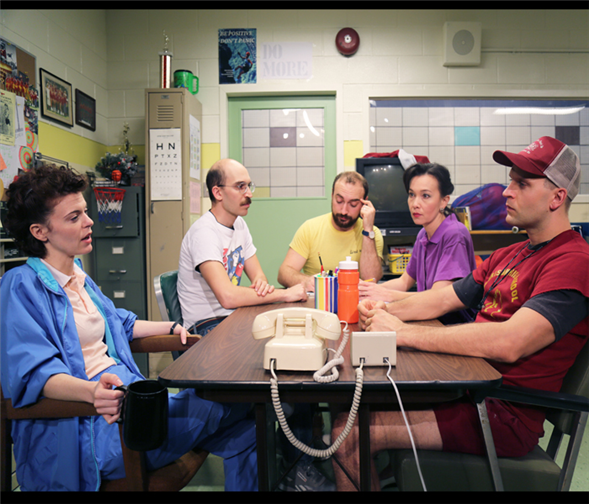Translate Page

After a sold-out 2016 run at The Bushwick Starr, Miles for Mary has transferred Off-Broadway to Playwrights Horizons from January 11 to February 25, 2018. This article refers to the original Brooklyn mounting.
The Mad Ones riff on high school teachers with passion to spare
---
"The endeavor of making an ensemble piece can feel a bit like an extended game of telephone," says Lila Neugebauer, who is one of four co-artistic directors of the Mad Ones and the director of the group's latest show Miles for Mary, which runs through November 12 at the Bushwick Starr.
The Drama Desk-nominated Mad Ones, which includes Marc Bovino (writer/performer), Joe Curnutte (writer/performer), Stephanie Wright Thompson (writer/performer), and Neugebauer, is known for its detailed investigations of American nostalgia. Miles for Mary is no exception. Set in a phys ed teachers' lounge in a Midwestern high school in 1988, the show follows a group of educators who painstakingly plan a telethon in order to raise money for a student scholarship. This leads to both a slow-burn meditation on what it means to make something with others and a hilarious and heartbreaking love letter to high school teachers who care.
"Devised theatre" is often a catchall term for any work that falls outside the traditional playwriting model, but for the Mad Ones devising is rigorous and specific. "Each process for our plays has been idiosyncratic," says Neugebauer, noting that a project often necessitates a vocabulary all its own.
For starters there is a three-month period of brainstorming in which collaborators bring in whatever is on their mind. Inspirational material has included YouTube videos, articles, books, and objects. For Miles for Mary, which was created in collaboration with Amy Staats and Stacey Yen, Neugebauer says, "We stumbled onto the question: What are your limits? Physically, spiritually, mentally?" Added to that inquiry was an interest in women runners and the idea for a telethon.
{Image1}
The next phase of the process involves "writing prompts and writing on our feet," says Neugebauer. This can involve spontaneous monologues, pen-to-paper drafting, and scene improvisations. Every actor takes a stab at playing the various characters that are created. "Once the cast of characters emerges, that's our critical threshold," Neugebauer adds.
From there the group tapes the improvs and Neugebauer gives feedback, which might involve giving a secret prompt to an actor, asking an actor to play with a new objective, or changing the given circumstances of a scene. A moment might be improvised three to 20 times, and these improvisations are transcribed. Within an improvised scene the group will also "jazz the beat," which could be defined as riffing around a particular moment. "It's actor-driven writing so we will improv a few different times around a five-line exchange," Neugebauer says. "Then we cull the gems to make the scene."
And while an initial editor transcribes the improvisations, everyone ultimately takes a stab at editing. "That will get us to an initial draft, which we call a Frankenstein," Neugebauer says. "Then we begin to workshop that [material] like a new play and hand off who the editor is."
Laughing, she adds, "It's terribly inefficient."
It's also terrifically detailed. Unlike a game of telephone, the end result isn't just a collage of "text by committee," but a singular work with a singular voice.
Neugebauer says the particular process of creating Miles for Mary has resembled a TV writers' room. "I'm a bit more like a show runner. It's still a collective vision—together we break the season and brainstorm the structure of the play. And, to borrow language from the play, 'Everyone has to get on the bus.'"
Indeed, the language in Miles for Mary often draws on the platitudes of uplifting educational posters. Neugebauer calls the aesthetic "sad / bad"—like a blend of The Office and Christopher Guest's ensemble-driven films. "We make small worlds where people take their jobs very seriously," says Neugebauer, who points out there can be a danger in aiming for the low hanging fruits of easy humor. "The stuff that's funny in this play emerges not from situational comedy but from a heartbreaking truth about the hopes and dreams of people living in the middle of the country in 1988."
Interestingly, Miles for Mary is the first Mad Ones play that's set in a time period the company members are old enough to remember. "We have some distance now to our adolescence," Neugebauer says. "We're in our 30s, and I think this play is an extension to where we are in our lives. It's a love letter to the high school teachers' lives we never bothered to ask about."
---
Eliza Bent is a writer and performer living in Brooklyn.
Photos provided by The Mad Ones. Top photo: The cast of 'Miles for Mary.'
TDF Members: Go here to browse our latest discounts for theatre, dance, and concerts.